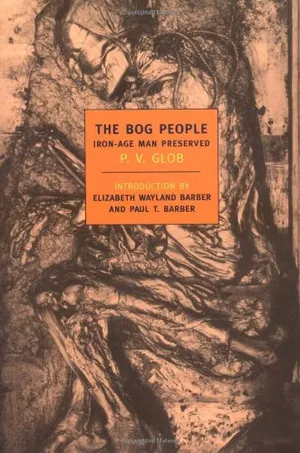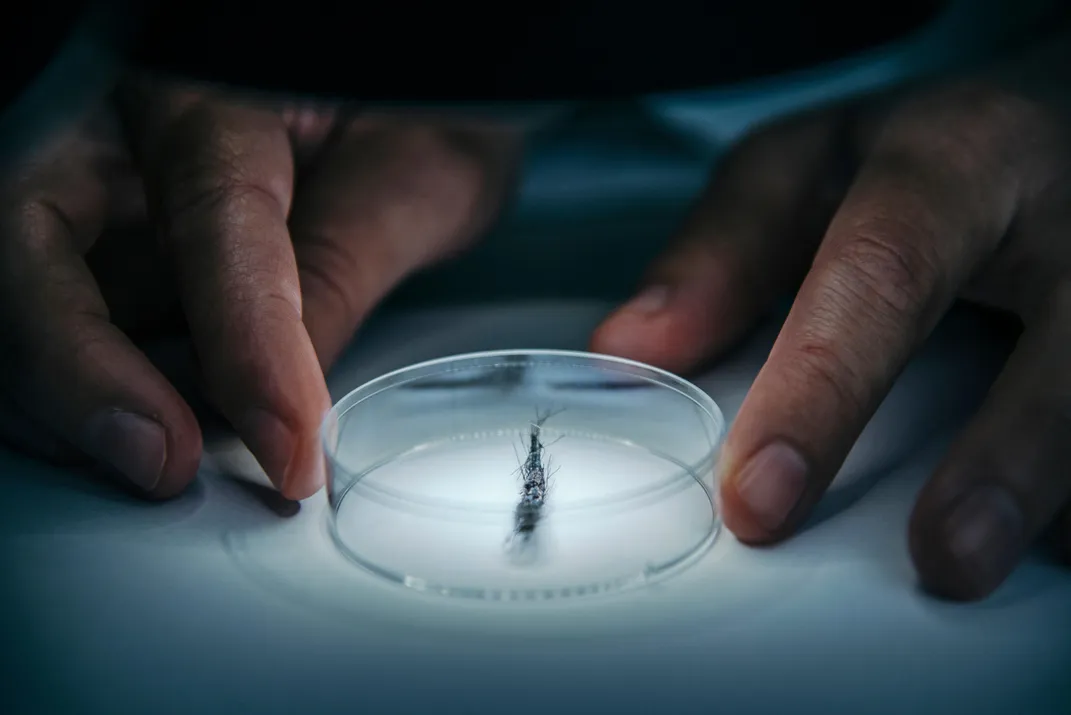Europe’s Famed Bog Bodies Are Starting to Reveal Their Secrets
High-tech tools divulge new information about the mysterious and violent fates met by these corpses
/https://tf-cmsv2-smithsonianmag-media.s3.amazonaws.com/filer/46/a5/46a59223-d03b-41f4-83e9-8eb3ff8fa432/may2017_e09_bogbodies.jpg)
If you’re looking for the middle of nowhere, the Bjaeldskovdal bog is a good place to start. It lies six miles outside the small town of Silkeborg in the middle of Denmark’s flat, sparse Jutland peninsula. The bog itself is little more than a spongy carpet of moss, with a few sad trees poking out. An ethereal stillness hangs over it. A child would put it more simply: This place is really spooky.
I drove here on a damp March day with Ole Nielsen, director of the Silkeborg Museum. We tramped out to a desolate stretch of bog, trying to keep to the clumps of ocher-colored grass and avoid the clingy muck between them. A wooden post was planted to mark the spot where two brothers, Viggo and Emil Hojgaard, along with Viggo’s wife, Grethe, all from the nearby village of Tollund, struck the body of an adult man while they cut peat with their spades on May 6, 1950. The dead man wore a belt and an odd cap made of skin, but nothing else. Oh yes, there was also a plaited leather thong wrapped tightly around his neck. This is the thing that killed him. His skin was tanned a deep chestnut, and his body appeared rubbery and deflated. Otherwise, Tollund Man, as he would be called, looked pretty much like you and me, which is astonishing considering he lived some 2,300 years ago.
The first time I saw him in his glass case at the Silkeborg Museum, a kind of embarrassed hush came over me, as if I had intruded on a sacred mystery. Apparently, this happens frequently. “Most people get very silent,” says Nielsen. “Some people faint, but that’s rare.”
What really gets you is his lovely face with its closed eyes and lightly stubbled chin. It is disconcertingly peaceful for someone who died so violently. You’d swear he’s smiling, as if he’s been dreaming sweetly for all those centuries. “It’s like he could wake up at any moment and say, ‘Oh, where was I?’” says Nielsen, who has clearly fallen under Tollund Man’s spell himself. “Looking at his face, you feel you could take a trip back 2,300 years to meet him. I would like to put a USB plug into his well-preserved brain and download everything that’s on it, but that’s impossible. He’s reluctant to answer.”
Reluctant perhaps, but not altogether unwilling. Archaeologists have been asking the same questions since the Hojgaards first troubled Tollund Man’s long sleep: Who are you? Where did you come from? How did you live? Who murdered you and why? But the way the researchers ask the questions, using new forensic techniques like dual-energy CT scanners and strontium tests, is getting more sophisticated all the time. There’s new hope that, sometime soon, he may start to speak.
Scholars tend to agree that Tollund Man’s killing was some kind of ritual sacrifice to the gods—perhaps a fertility offering. To the people who put him there, a bog was a special place. While most of Northern Europe lay under a thick canopy of forest, bogs did not. Half earth, half water and open to the heavens, they were borderlands to the beyond. To these people, will-o’-the-wisps—flickering ghostly lights that recede when approached—weren’t the effects of swamp gas caused by rotting vegetation. They were fairies. The thinking goes that Tollund Man’s tomb may have been meant to ensure a kind of soggy immortality for the sacrificial object.
“When he was found in 1950,” says Nielsen, “they made an X-ray of his body and his head, so you can see the brain is quite well-preserved. They autopsied him like you would do an ordinary body, took out his intestines, said, yup it’s all there, and put it back. Today we go about things entirely differently. The questions go on and on.”
Lately, Tollund Man has been enjoying a particularly hectic afterlife. In 2015, he was sent to the Natural History Museum in Paris to run his feet through a microCT scan normally used for fossils. Specialists in ancient DNA have tapped Tollund Man’s femur to try to get a sample of the genetic material. They failed, but they’re not giving up. Next time they’ll use the petrous bone at the base of the skull, which is far denser than the femur and thus a more promising source of DNA.
Then there’s Tollund Man’s hair, which may end up being the most garrulous part of him. Shortly before I arrived, Tollund Man’s hat was removed for the first time to obtain hair samples. By analyzing how minute quantities of strontium differ along a single strand, a researcher in Copenhagen hopes to assemble a road map of all the places Tollund Man traveled in his lifetime. “It’s so amazing, you can hardly believe it’s true,” says Nielsen.
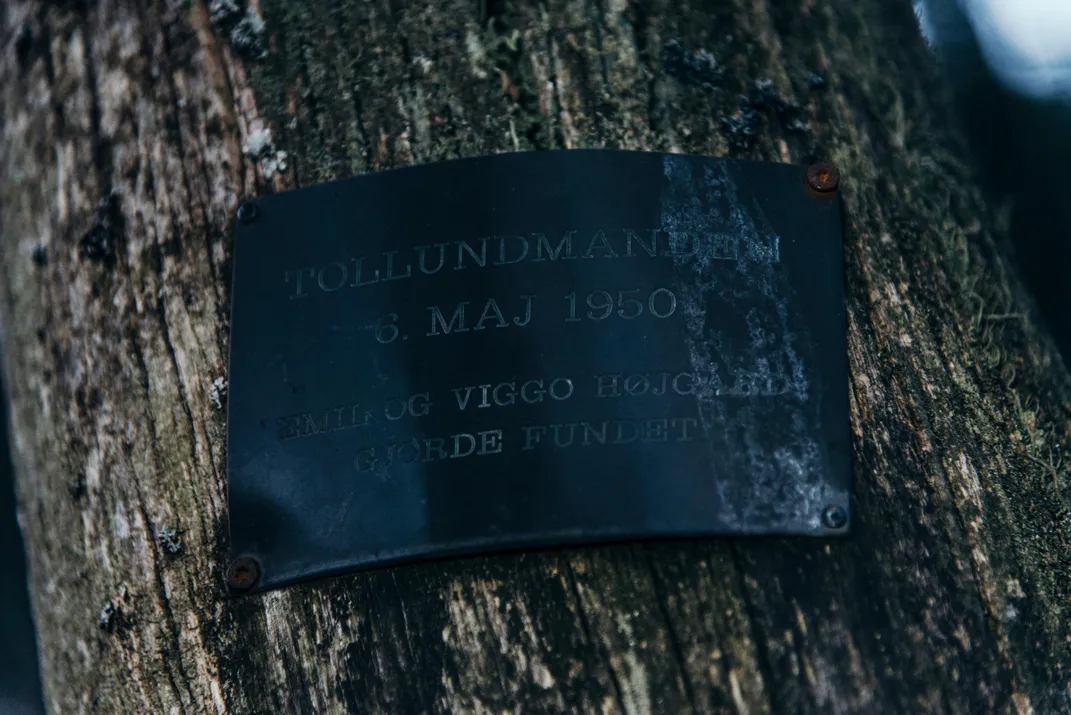
Tollund Man is the best-looking and best-known member of an elite club of preserved cadavers that have come to be known as “bog bodies.” These are men and women (also some adolescents and a few children) who were laid down long ago in the raised peat bogs of Northern Europe—mostly Denmark, Germany, England, Ireland and the Netherlands. Cashel Man, the community’s elder statesman, dates to the Bronze Age, around 2,000 B.C., giving him a good 700 years on King Tut. But his age makes him an outlier. Radiocarbon dating tells us that the greater number of bog bodies went into the moss some time in the Iron Age between roughly 500 B.C. and A.D. 100. The roster from that period is a bog body Who’s Who: Tollund Man, Haraldskjaer Woman, Grauballe Man, Windeby Girl, Lindow Man, Clonycavan Man and Oldcroghan Man.
They can keep speaking to us from beyond the grave because of the environment’s singular chemistry. The best-preserved bodies were all found in raised bogs, which form in basins where poor drainage leaves the ground waterlogged and slows plant decay. Over thousands of years, layers of sphagnum moss accumulate, eventually forming a dome fed entirely by rainwater. A raised bog contains few minerals and very little oxygen, but lots of acid. Add in low Northern European temperatures, and you have a wonderful refrigerator for conserving dead humans.
A body placed here decomposes extremely slowly. Soon after burial, the acid starts tanning the body’s skin, hair and nails. As the sphagnum moss dies, it releases a carbohydrate polymer called sphagnan. It binds nitrogen, halting growth of bacteria and further mummifying the corpse. But sphagnan also extracts calcium, leached out of the body’s bones. This helps to explain why, after a thousand or so years of this treatment, a corpse ends up looking like a squished rubber doll.
Nobody can say for sure whether the people who buried the bodies in the bog knew that the sphagnum moss would keep those bodies intact. It appears highly unlikely—how would they? Still, it is tempting to think so, since it fits so perfectly the ritualistic function of bog bodies, perhaps regarded as emissaries to the afterworld.
Besides, there’s also the odd business of bog butter. Bodies weren’t the only things that ended up in the bogs of Northern Europe. Along with wooden and bronze vessels, weapons and other objects consecrated to the gods, there was also an edible waxy substance made out of dairy or meat. Just this past summer, a turf-cutter found a 22-pound hunk of bog butter in County Meath, Ireland. It is thought to be 2,000 years old, and while it smells pretty funky, this Iron Age comestible would apparently work just fine spread on 21st-century toast. Like the vessels and weapons, bog butter may have been destined for the gods, but scholars are just as likely to believe that the people who put it there were simply preserving it for later. And if they knew a bog would do this for butter, why not the human body too?
Much of what we know about bog bodies amounts to little more than guesswork and informed conjecture. The Bronze and Iron Age communities from which they come had no written language. There’s one thing we do know about them, because it is written on their flesh. Nearly all appear to have been killed, many with such savagery that it lends an air of grim purposefulness to their deaths. They’ve been strangled, hanged, stabbed, sliced and clobbered on the head. Some victims may have been murdered more than once in several different ways. Scholars have come to call this overkilling, and it understandably provokes no end of speculation. “Why would you stab someone in the throat and then strangle them?” wonders Vincent van Vilsteren, curator of archaeology at Drents Museum in Assen, the Netherlands, home of the bog body known as Yde Girl.
We may never get a clear answer, and it now seems unlikely that a single explanation can ever fit all the victims. But the question keeps gnawing at us and gives bog bodies their clammy grip on the imagination. For some strange reason, we identify. They are so alarmingly normal, these bog folk. You think, there but for the grace of the goddess went I.
That’s what overcomes the visitors in Tollund Man’s presence. Seamus Heaney felt it, and wrote a haunting and melancholy series of poems inspired by the bog bodies. “Something of his sad freedom as he rode the tumbril should come to me, driving, saying the names Tollund, Grauballe, Nebelgard,” Heaney writes in his poem “Tollund Man.”
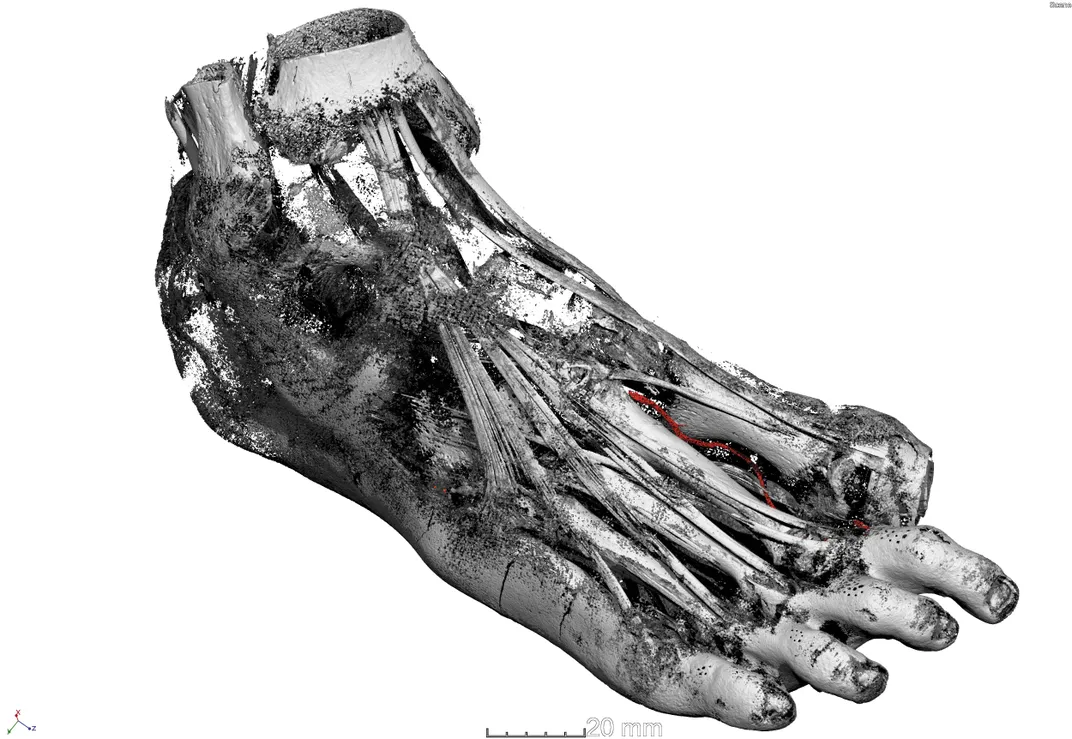
It’s hard to say exactly how many bog bodies there are (it depends on whether you count just the fleshy bog bodies or include bog skeletons), but the number is probably in the hundreds. The first records of them date to the 17th century, and they’ve been turning up fairly regularly since then. (Before that, bodies found in bogs were often given a quick reburial in the local churchyard.)
We’re finding them less frequently now that peat has greatly diminished as a source of fuel. To the extent that peat still gets cut at all—environmentalists oppose peat extraction in these fragile ecosystems—the job now falls to large machines that often grind up what might have emerged whole from the slow working of a hand spade.
That doesn’t mean the odd bog body doesn’t still turn up. Cashel Man was unearthed in 2011 by a milling machine in Cul na Mona bog in Cashel, Ireland. In 2014, the Rossan bog in Ireland’s County Meath yielded a leg and arm bones and another leg last year. “We know something hugely significant is going on here. We’ve found wooden vessels here. We’ve found bog butter. This bog is a very sacred place,” says Maeve Sikora, an assistant keeper at the National Museum of Ireland in Dublin, who is investigating the Rossan finds.
The search for the origins of bog bodies and their secrets goes back a fairly long way, too. In 1780, a peat-cutter found a skeleton and a plait of hair in a bog on Drumkeragh Mountain. The property belonged to the Earl of Moira, and it was his wife, Elizabeth Rawdon, Countess of Moira, who pursued what we believe to be the first serious investigation of such a find, publishing her results in the journal Archaeologia.
As more bog bodies turned up, more questions got asked. In the absence of clear answers, mythmaking and fancy rushed in to fill the void. On October 20, 1835, workmen digging a ditch in the Haraldskjaer Fen on Denmark’s Jutland peninsula came across the well-preserved body of a woman, about 5-foot-2 with high cheekbones and long, dark hair. She was clamped to the moss with small staves through her elbows and knees.
Danish historian and linguist Niels Matthias Petersen identified her as Queen Gunhild of Norway, who, legend tells us, died around 970, and was notoriously cruel, clever, wanton and domineering.
Bog Borderlands
(Map Credit: Guilbert Gates)
According to the old stories, the Viking king Harald Bluetooth of Denmark enticed Gunhild over from Norway to be his bride. When she arrived, however, he drowned her and laid her deep in Gunnelsmose (Gunhild’s Bog). This explanation was not only accepted when Petersen first advanced it in 1835, it was celebrated; Queen Gunhild became a reality star. Around 1836, Denmark’s King Frederick VI personally presented her with an oak coffin, and she was displayed as a kind of Viking trophy in the Church of St. Nicholas in Vejle.
Among the few dissident voices was that of a scrappy student, J.J.A. Worsaae, one of the principal founders of prehistoric archaeology. Worsaae believed the folklore-based identification was hooey. He argued persuasively that the woman found in Haraldskjaer Fen should be grouped with other Iron Age bog bodies. In 1977, carbon dating proved him right: Haraldskjaer Woman—no longer referred to as Queen Gunhild—had lived during the fifth century B.C. Moreover, a second postmortem in the year 2000 found a thin line around her neck that had gone undetected. She had not been drowned but strangled. This changed everything, except perhaps for the victim.
In the absence of hard evidence, the temptation to weave bog bodies into a national narrative proved hard to resist. The most notorious effort to lay claim to the bog bodies came in the mid-1930s, when the Nazis repurposed them to buttress their own Aryan mythology. By this time, two views prevailed. It was largely accepted that the majority of bog bodies dated to the Bronze and Iron Ages, but their murder was ascribed either to ritual sacrifice or criminal punishment. This latter interpretation rested heavily on the writings of the Roman historian Publius Cornelius Tacitus, whose Germania, written in A.D. 98, portrays social customs in the northern parts of the empire.
On the whole, Tacitus thought highly of the local inhabitants. He praised their forthrightness, bravery, simplicity, devotion to their chieftains and restrained sexual habits, which frowned on debauchery and favored monogamy and fidelity. These were the noble savages the Nazis wanted to appropriate as direct forebears, and Heinrich Himmler, head of the Gestapo and the SS, established an archaeological institute, the Ahnenerbe, to justify that claim “scientifically.”
To the researchers at the Ahnenerbe, bog bodies were the remains of degenerates who had betrayed the ancient code. In a key passage, Tacitus writes: “The punishment varies to suit the crime. Traitors and deserters are hanged on trees; the cowardly, the unwarlike and those who disgrace their bodies are drowned in miry swamps under a cover of wicker.” Professor and SS-Untersturmfuhrer Karl August Eckhardt interpreted this last phrase to mean homosexuals. It was just a hop from here to the Nazis’ ferocious persecution of gay people.
“The Ahnenerbe’s was the dominant theory of bog bodies at the time, and it was dangerous to question it,” says Morten Ravn, a Danish curator who has published a historical overview of bog body research. One of the few who dared was a historian of culture named Alfred Dieck, who perhaps felt himself protected by his own Nazi Party membership. Dieck’s research demonstrated that bog bodies came from too wide an area over too long a span of time to represent proto-Germanic legal practice. But the man who torpedoed the Aryan theory of bog bodies was prevented from working as an archaeologist after the war because of his Nazi past. Ravn says, “He was really quite an unfortunate person.”
Shortly after Tollund Man was discovered, the detective in charge of what was initially a missing persons investigation had the good sense to call in Peter Vilhelm Glob, who had recently been appointed professor of archaeology at the university in Aarhus, the nearest big city. P. V. Glob, as everyone refers to him, has stamped his name more deeply than anyone else on the riddle of the bog bodies. His book, The Bog People—to the bighearted Glob, they were people, not bodies—was hailed as a modest masterpiece when it appeared in 1965. It is sharp, authoritative and moving all at once, and it remains intensely readable. Glob, who died in 1985, succeeded not only in providing the scaffolding for our understanding of Tollund Man and his kin, but in restoring their humanity as well. He conjured bog bodies back to life and made the world take notice of them. It was Glob who introduced Seamus Heaney to Tollund Man.
In Glob’s view, Tollund Man and most of the others were sacrificed to Nerthus, the Earth Mother, to ensure a good crop. We can see the goddess paraded around, surrounded by fabulous animals, on the great silver Gundestrup cauldron, buried as a sacrifice in a Danish bog not far from where several Iron Age bodies were also found. Glob notes pointedly that the cauldron’s goddesses all wear neck rings and twisted bands on their foreheads—“like the ropes round the necks of sacrificed bog men.”
They were strung up at winter’s end or early spring. We know Tollund Man was hanged, from the mark of the leather high up on his throat; “if he was strangled, it would have been lower down,” Ole Nielsen explains. And we know roughly the time of year when this occurred from the seasonal contents found in his stomach and that of other victims: barley, linseed and knotweed, among others, but no strawberries, blackberries, apples or hips from summer and autumn.
The ominous conclusion is clear, Glob informs us: The winter gruel was a special last supper intended to hasten the coming of spring, “on just such occasions that bloody human sacrifices reached a peak in the Iron Age.”
Glob is fine—much better than fine—as far as he goes, but he doesn’t go nearly far enough, as he would no doubt agree. “I’m still trying to get nearer to Tollund Man,” says Ole Nielsen. “In my view, he could have been a willing victim, perhaps chosen from childhood—I see nothing degrading about that. Or maybe they drew straws—‘Oh damn! Well, better you than me!’
“If we had his DNA, maybe we could say where he came from—his clan, from the north, from Greece, wherever. Could he drink milk? Was he prone to diabetes? What about arteriosclerosis? That’s one of the reasons we sent him for a microCT scan in Paris, to look into his arteries.”
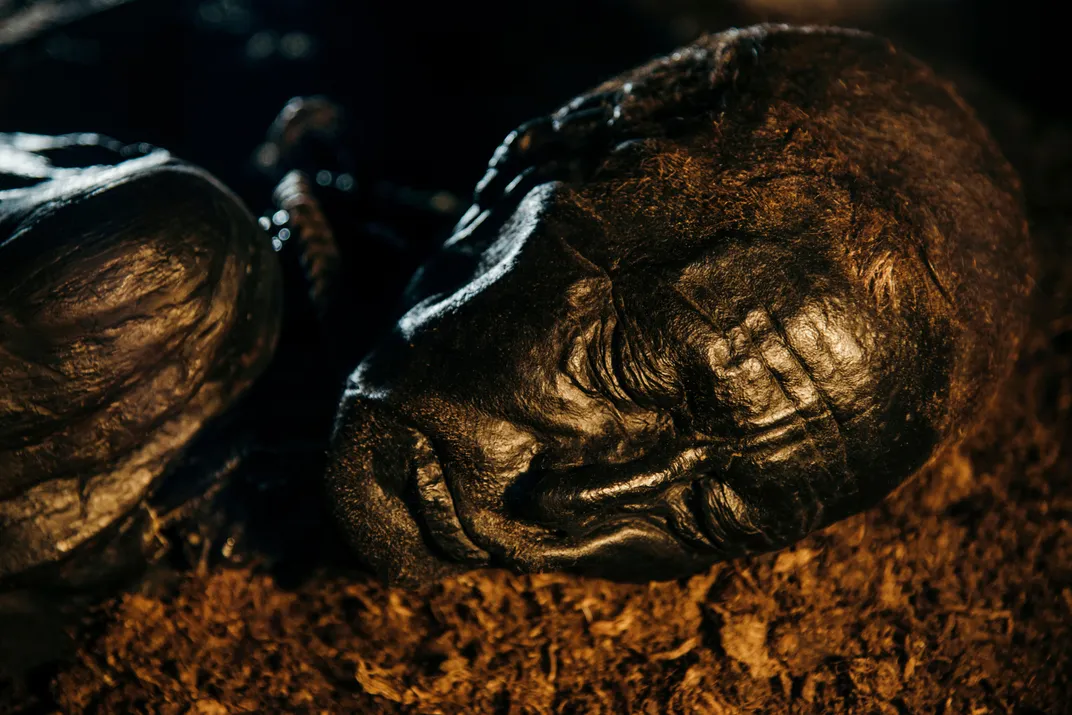
Maybe we shouldn’t even be using the term bog bodies at all anymore, insofar as it tends to impose a unified explanation on a diverse phenomenon. The first museum exhibition Julia Farley recalls seeing as a child is the Lindow Man in the British Museum. Lindow Man is the most intact of several bodies discovered in the Lindow Moss in Cheshire, England, during the 1980s.
“I still come and say hello to him whenever I’m in the gallery,” says Farley, a curator at the British Museum. Except, says Farley, he may not be quite the same Lindow Man she first encountered all those years ago.
Carbon dating puts his death somewhere between 2 B.C. and A.D. 119. We have only the upper half of him, but besides that he’s in fine shape. He once stood around 5-foot-6. His beard and mustache had been clipped by shears. His manicured fingernails suggest he didn’t work too hard. His brow is furrowed in consternation. He was just 25 or so when he died, and he died a particularly horrible death. “One of the doctors who examined him originally found he had been kneed in the back to bring him to his knees, garroted, had his throat slit, his neck broken, got bashed in the head and was left to drown in the bog,” says Farley. “This is the so-called ‘triple death,’ and it’s the model that’s been taken forward.”
Farley isn’t so sure, and she’s not the only one. First, the physical evidence is inconclusive. Farley thinks the sinew tied around Lindow Man’s neck could as easily be a necklace as a garrote. Moreover, some of Lindow Man’s “wounds” might have occurred after death from the crushing weight of peat moss over centuries. Different fracturing patterns distinguish bones that fracture before death, when they are more flexible, from bones that fracture after death. It matters greatly, too, whether Lindow Man lived before or after the Roman conquest of Britain around A.D. 60. Among other sweeping cultural changes that came in with the Romans, human sacrifice was outlawed. What’s more, post-Glob, the Tacitus consensus has broken down. It turns out, Tacitus never visited the regions he wrote about, but compiled his history from other contemporary accounts. “There’s a lot of problematic issues with Tacitus,” says Morten Ravn. “He is still a research source, but you’ve got to be careful.”
All things considered, Lindow Man has gotten roped into a tidy, satisfyingly creepy meta-narrative of ritual killing. “For me, we’ve got to disentangle Lindow Man from that story,” says Farley. “There’s clearly something a bit weird happening in Cheshire in the early Roman period. But we can’t say whether these people are being executed, whether they’ve been murdered, whether they’ve been brought there and disposed of, or ritually killed for religious reasons. However it turns out, they’re not part of the same picture as the Danish bog bodies. We need to approach Lindow Man and the other bodies from Lindow Moss as individuals—as people.”
Last October, Lindow Man was taken for a short walk to London’s Royal Brompton Hospital, which has a dual-energy CT scanner. The scanner uses two rotating X-ray machines, each set to different wavelengths.
“It gives you amazing clarity for both the thicker parts, such as bones, and the more delicate parts, such as skin,” says Daniel Antoine, the British Museum’s curator of physical anthropology. “We’re using a dual-energy scanner in conjunction with VGStudio Max, one of the best software packages to transform those X-ray slices into a visualization. It’s the same software used in Formula One to scan brake pads after a race to reconstruct what’s happened on the inside without having to dismantle it. The software in most hospitals isn’t half as powerful as this. We’re really trying to push the science as much as possible.”
In September 2012, the museum ran a dual-energy scan on Gebelein Man, an Egyptian mummy from 3,500 B.C. that has been in its collection for more than 100 years. The scan probed hitherto unseen wounds in the back, shoulder blade and rib cage. The damage was consistent with the deep thrust of a blade in the back. Gebelein Man, it appeared, had been murdered. A 5,500-year-old crime had been revealed. Says Antoine, “Because the methods are constantly evolving, we can keep re-analyzing the same ancient human remains and come up with entirely new insights.”
In Ireland, Eamonn Kelly, formerly keeper of Irish Antiquities at the National Museum, claims a distinct narrative for his preserved Irish countrymen. In 2003, peat cutters found Oldcroghan Man and Clonycavan Man in two different bogs. Both had lived between 400 and 175 B.C., and both had been subjected to a spectacular variety of depredations, including having their nipples mutilated. This and other evidence led Kelly to propose the theory that the Celtic bog bodies were kings who had failed in their duties. The role of the king was to ensure milk and cereals for the people. (He fills this sacral role by a kingship-marriage with the goddess, who represents fertility and the land itself.) Kelly’s theory was a significant break from bog body orthodoxy. As he explains it, St. Patrick tells us that sucking the king’s nipples was a rite of fealty. So lacerated nipples, no crown, either here or in the hereafter.
“In Ireland, the king is the pivotal member of society, so when things go wrong, he pays the price,” says Kelly. “All the new bodies discovered since then have reaffirmed this theory. The ritual sacrifice may be the same principle as in the Teutonic lands, but here you’ve got a different person carrying the can. To have one explanation that fits bog bodies across Europe just isn’t going to work.”
Even the Danish bog bodies who furnish the master narrative are being re-examined to determine how well P. V. Glob’s old story still fits. Peter de Barros Damgaard and Morton Allentoft, two researchers from Copenhagen’s Centre for GeoGenetics, recently examined one of Haraldskjaer Woman’s teeth and a piece of the skull’s petrous bone. They were trying to get a decent sample of her DNA to determine her gene pool. To get a workable sample would be a godsend for bog body research, since it could clarify whether she was an outsider or a local. To date, it has been almost impossible to get because the acid in bogs causes DNA to disintegrate. But if there’s any hope of obtaining some, the sample would likely come from the teeth or petrous bone, since their extreme density protects DNA well.
Thus far, the results have proved disappointing. Damgaard did manage to extract a bit of DNA from Haraldskjaer Woman’s tooth, but the sample proved too small. “I have no way to certify that the 0.2 percent of human DNA in the sample isn’t contaminated,” Damgaard wrote to me, after almost a full year’s work. “You could say that the genomic puzzle has been broken into pieces so small that they carry no information.” He sounded a little melancholy about it but resigned. “The DNA of the Haraldskjaer Woman will be beyond our reach forever, so she can lie down and rest.”
Karin Margarita Frei, professor of archaeometry/archaeological science at the National Museum of Denmark, had somewhat better luck performing a different kind of analysis on Haraldskjaer Woman’s hair. Frei uses strontium isotope analyses in her research. Strontium is present nearly everywhere in nature, but in proportions that vary from one place to another. People and animals absorb this strontium through eating and drinking in the proportions characteristic of the place they’re in at the time—specifically, the ratio of the isotopes strontium 87 to strontium 86. We have pretty good maps for the strontium characteristics of different countries, so by matching a particular body’s strontium makeup to the map, we can tell where its owner has been—and not just at one moment, but over time.
As with DNA, the best places to mine strontium are a person’s teeth and bones. The strontium isotope ratio in the first molar enamel shows where you come from originally, the long bone of the leg will show where you spent the last ten years of your life, and a rib will localize you for the last three or four years. The problem is that bog bodies often have no bones and their teeth are terribly degraded.
Frei had a revelation. Why not gather strontium from human hair? “When I saw Haraldskjaer Woman’s hair in 2012, almost 50 centimeters long, I realized I had the perfect material to investigate rapid mobility, since it works as a kind of fast-growing archive. It was an incredible moment for me,” Frei told me. Strontium, she says, enables her to “trace travels in the last years of a person’s life.”
Hair contains at most a few parts per million of strontium, often much less. And after burial in a bog for a few thousand years, hair is often fatally contaminated with dust and microparticles.
It took Frei three years to develop a technique for cleaning hair and extracting usable strontium samples from it, but when she did, the results were startling. “The small amount of enamel we got from Haraldskjaer Woman’s teeth said she was raised locally, but the tip of her hair told us that in the months before her death she went quite far. The low strontium signature indicates a volcanic area—maybe the middle of Germany, or the UK.”
Frei did a similar analysis on Huldremose Woman, a 2nd-century B.C. bog body found in 1879 in a peat bog near Huldremose, Denmark. Similar results.
“Both women were traveling just before they died,” says Frei. “It made me think that if they were sacrificed, maybe they made the trip as part of the sacrifice. We may have to rethink the whole sacrifice question because of strontium.”
How fruitful a way forward are these high-tech invasions of the flesh? Eamonn Kelly, the Irish bog body scholar, urges caution and humility. “They just don’t know enough to say, this is a person from France who turned up in Ireland. I do think we’re going to get useful scientific advances that we can’t even comprehend now, but there’s also a lot of pseudoscience in the field of archaeology. Scientists give you a particular result, but they don’t tell you about the limitations and the drawbacks.”
In this case, it might turn out that Ole Nielsen is troubling Tollund Man’s dreamless sleep for very little. One of the reasons for taking off Tollund Man’s hat was to send a hair sample to Karin Frei. “Ole has been after me to do this for some time, but Tollund Man’s hair is very short,” says Frei.
Almost a year after telling me this, Frei wrote to give me an early preview of her results. They were meager—much less informative than Frei’s investigations of Haraldskjaer Woman. Frei compared the strontium in Tollund Man’s short hair with the strontium in his femur. Small differences in the strontium isotope’s proportions between the two samples suggest that while he spent his final year in Denmark, he might have moved at least 20 miles in his final six months.
That’s critically important for Nielsen. Every new tidbit unravels another thread in the deeply human mystery of these bog bodies. “It will never end. There will always be new questions,” he says. “Tollund Man doesn’t care. He’s dead. This is all about you and me.”
Editor’s Note: Scientist Karin Frei performed her comparative analysis of the bog body Haraldskjaer Woman with Huldremose Woman, not Egtved Girl, as previously stated in the text.
